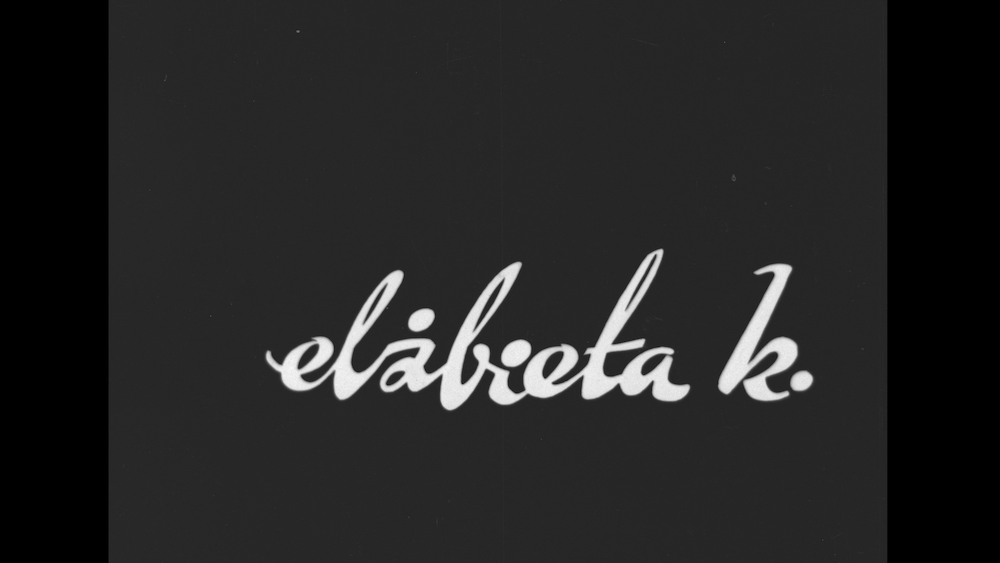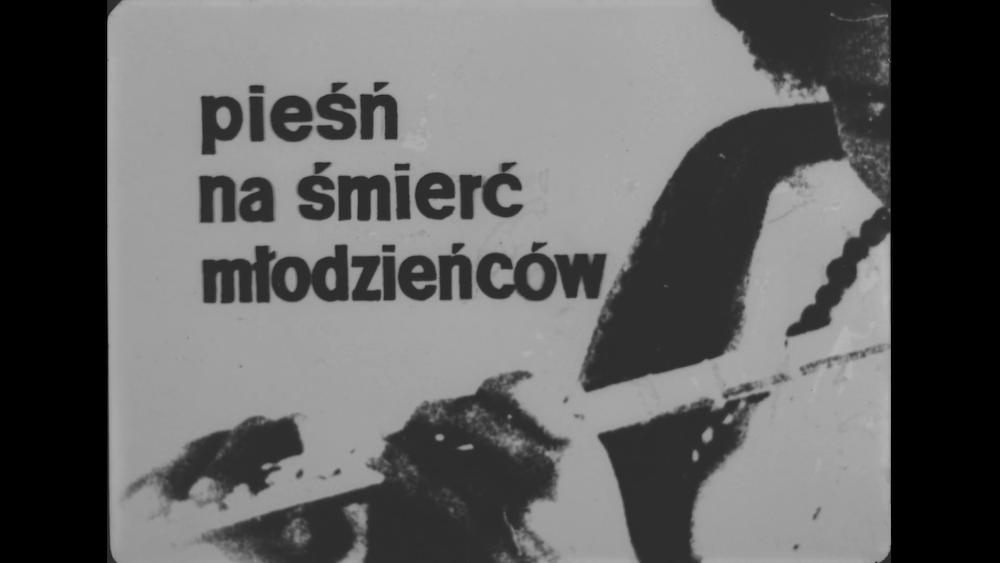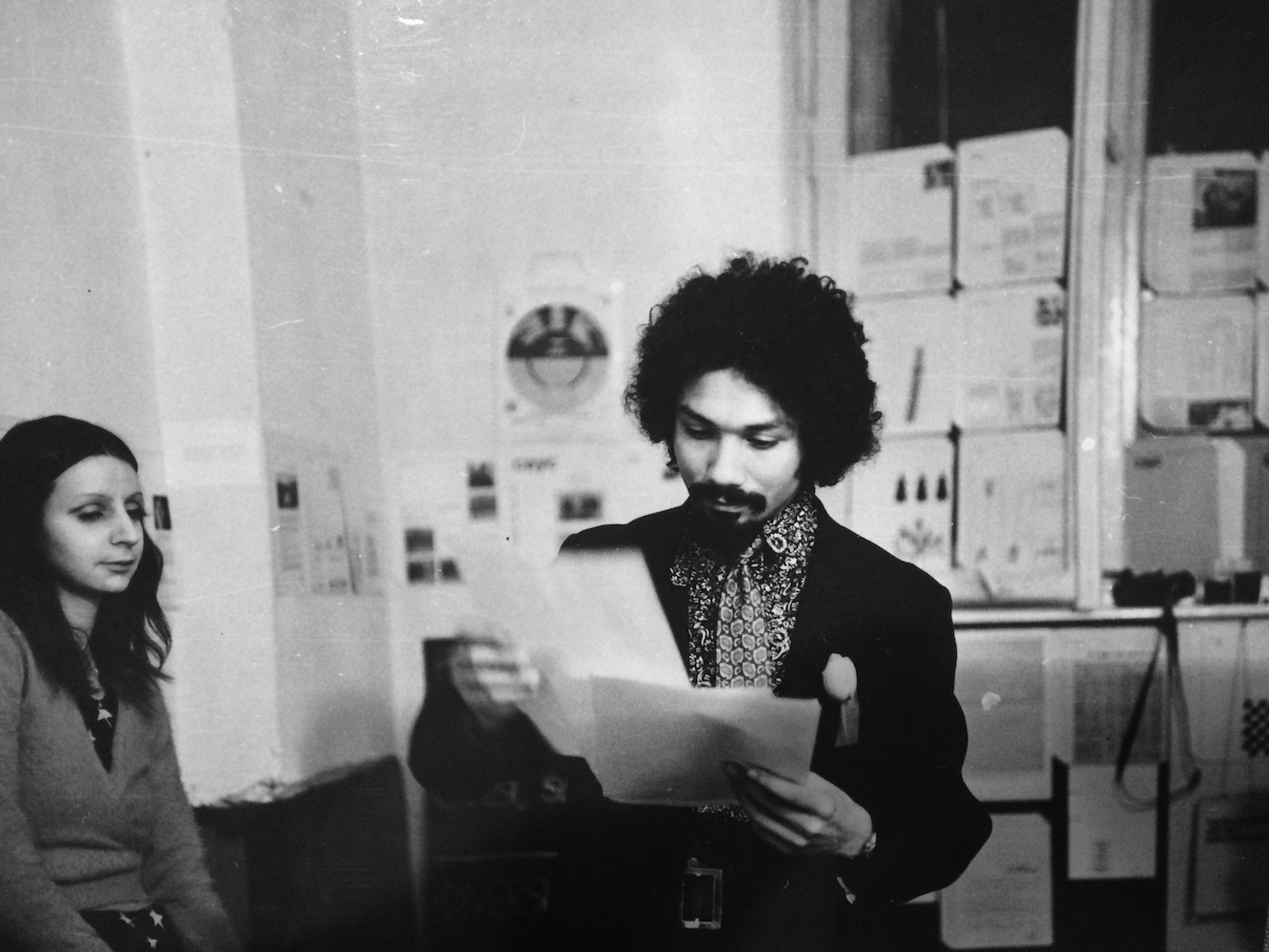
Ewa Partum and Abdelkader Lagtaa, Andrzej Partum Poetry Office, Warsaw, 1973, Andrzej Partum archives, Monopol Gallery
(4.3)
ABDELKADER LAGTAA
[Poetry and artistic experimentation]

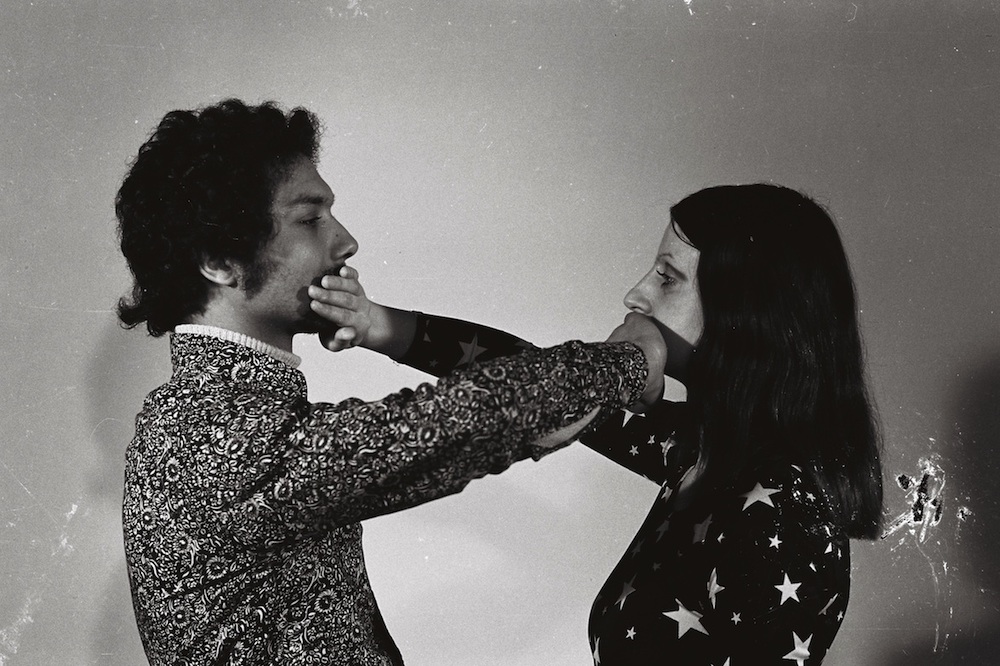


Ewa Partum, Conceptual Gymnastics, camera action, 1972, Courtesy of Ewa Partum, ARTUM Foundation, Ewa Partum Museum
Abdelkader Lagtaa is a poet, filmmaker, and writer born in Casablanca in 1948. He now lives in Paris with his Polish wife, Bozena Lagtaa, whom he met during his studies at the Lódź Film School, and from which he graduated in 1975.
He is known for his film Un amour à Casablanca [Love in Casablanca, 1991], which met with much public acclaim for having dared to confront the realities of Moroccan society, but also for La Porte Close [The Closed Door, 1995] and Les Casablancais [The Casablancans, 1999]. His films question power and its religious and political foundations.
On his return from Lódź, he co-directed the collective film Les Cendres du Clos [Cinders of the Vineyard, 1978] with the Derkaoui brothers. His last film, La Moitié du Ciel [Half the Sky, 2015], focuses on the years of political repression in Morocco and the arrest of Abdellatif Laabi for “crimes of opinion” at the beginning of the 1970s.
In the 1960s, while a film student in Poland, he published poems in the review Souffles and was an active member of the UNEM Polish branch.
In Lódź, Lagtaa collaborated with Polish conceptual artists, at times as a “secretary” (translator and assistant) of the artist Ewa Partum, but also by developing a personal artistic practice. He took part in performances in Elbag in northern Poland, where for example, he and Andrzej Partum “hijacked” a film screening by “performing acupuncture” on the screen. Click here for photographs of the performance (Rytka Archivum).
With only his typewriter, a gift from the poet Mostafa Nissaboury in 1968, Abdelkader Lagtaa engaged in poetic research with works such as “Poème de la réalité des limites de la réalité” [Poem about the reality of the limits of reality], “Variations I et II”, and “Nettainissement Linguistique” [Linguistic Cleanification], presented in an exhibition at the Poetry Office in Warsaw in 1973.
Once back in Morocco, Lagtaa completely abandoned his conceptual artistic practice and performative poetry to dedicate himself to the development of a Moroccan national cinema. This part of his biography, essential to understanding his transdisciplinary approach, had until recently been entirely overlooked. (N.B. A publication of his hitherto unpublished poetic and conceptual work is currently in preparation, led by Przemysław Strożek, Sara Lagnaoui and Léa Morin).
FILMOGRAPHY IN POLAND:
WACLAW
ABDELKADER LAGTAA, 5 min, 1969A Shadow Among Others
ABDELKADER LAGTAA, 5 min, 1969But Hope Is of a Different Colour
ABDELKADER LAGTAA, 9 min, 1972PODROZ
ABDELKADER LAGTAA, 17 min, 1975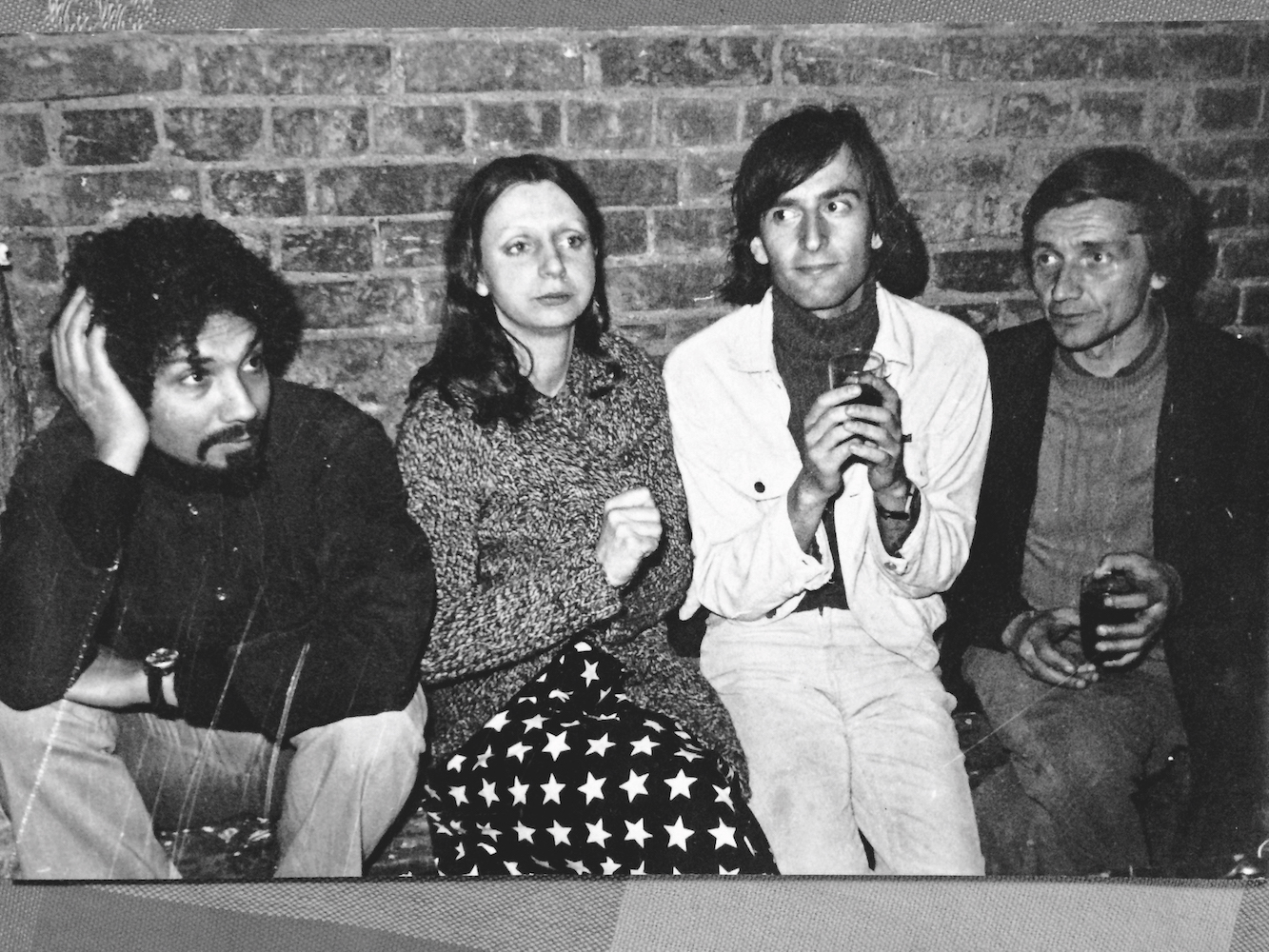
Abdelkader Lagtaa, Ewa Partum, Istvàn Nàdler and Andrzej Partum, Kino Laboratorium Biennale, Elbag, 1973, Andrzej Partum archives, Monopol Gallery

Abdelkader Lagtaa, Ryszard Tomczyk, Andrezj Partum and Gerard Bulm-Kwiatkowski, Kino Laboratorium Biennale, Elbag, 1973, Andrzej Partum archives, Monopol Gallery
︎
TESTIMONY OF EWA PARTUM (2020, submitted by Karolina Majewska-Güde):
“I met Kader through my English translator, Marek Żychski, who was friends with him. Given Galeria Adres' international profile, I needed help communicating with artists around the world - which at the time meant in English and French. Since my former translator Roland Paret wanted to leave Poland, I was actively looking for someone to replace him. And Marek brought Kader to us. As well as being a translator, Kader was someone very interested in conceptual art and my work. I was also concerned about his own artistic ambitions as a filmmaker. Working with Kader as an assistant was an obvious choice. The gallery did not gather a group of people interested in its activities. We didn't have a local audience or a lot of local contacts - rather an international network of exchange. Galeria Adres it was me and my two secretaries- Marek and Kader. So it could only have been one of them.
We were very aware of the situation in Morocco, of the Hassan II regime and, in particular, of Kader’s political problems. Furthermore, in its official rhetoric, the communist government emphasized its support for political refugees from the so-called “Third World” countries and its support for international socialism. I also played this card when applying for founds. Once we went to the cultural department of the city of Łódź with Kader and asked for support for non-bourgeois art that strengthens international comradeship.”
To find out more about Ewa Partum’s Galeria Adres:
GALERIA ADRES DOCUMENTATION (video)
︎




︎
Ewa Partum, book by Ewa, Conceptual Gymnastics, 1973, Courtesy of Ewa Partum, ARTUM Foundation, ewa partum museum

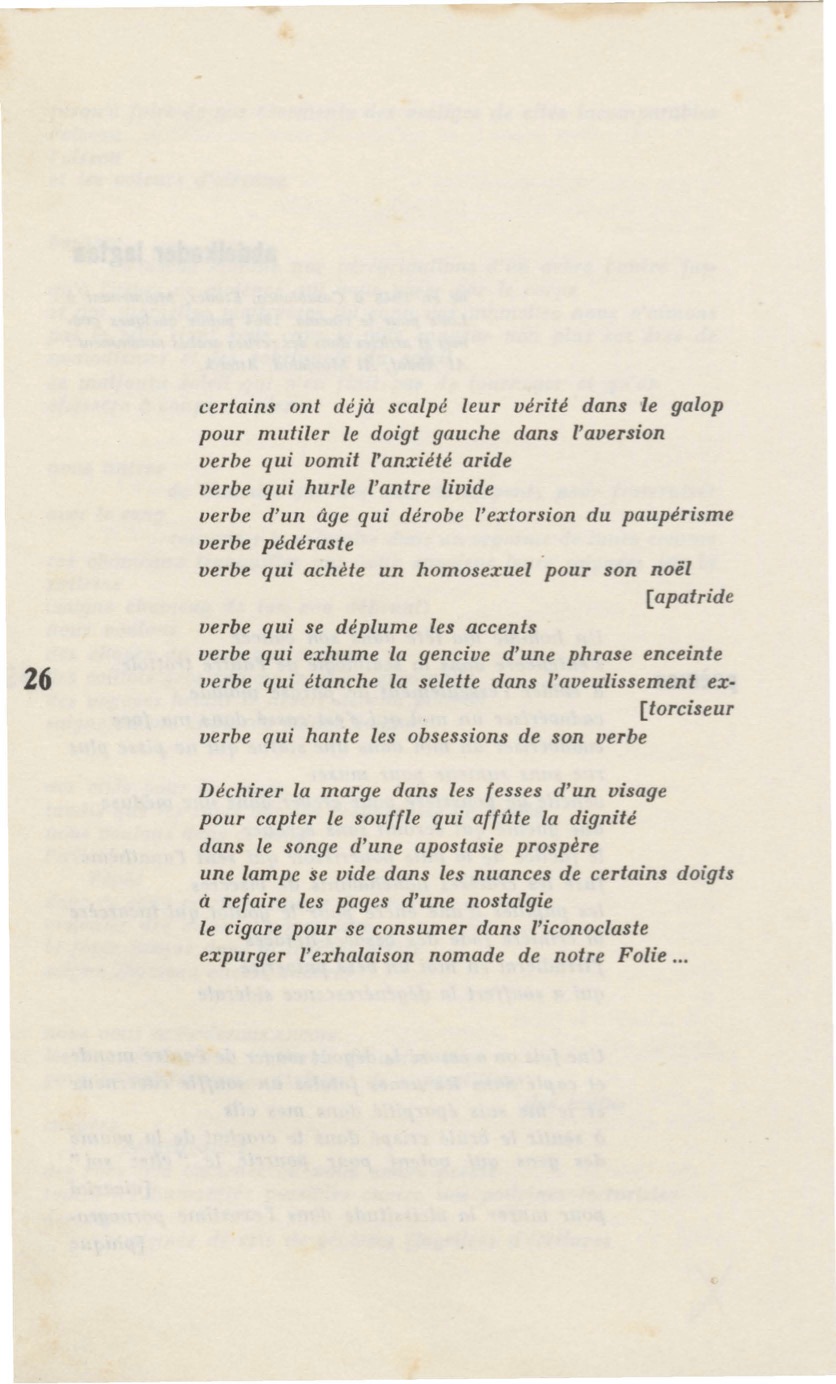

︎
Poems by Abdelkader Lagtaa, Souffles n°5, ed. Abdellatif Laabi, 1967
Poems by Abdelkader Lagtaa, Souffles n°5, ed. Abdellatif Laabi, 1967

︎
Letter from Abdelkader Lagtaa, Souffles n°4, ed. Abdellatif Laabi, 1966
Letter from Abdelkader Lagtaa, Souffles n°4, ed. Abdellatif Laabi, 1966

︎
Kader Lagtaa, Voyage Permanent Nettainissement Linguistique, Invitation to the Poetry Office, 23.02.1973 (Andrzej Partum archives, courtesy of Wanda Lacrampe)
Kader Lagtaa, Voyage Permanent Nettainissement Linguistique, Invitation to the Poetry Office, 23.02.1973 (Andrzej Partum archives, courtesy of Wanda Lacrampe)
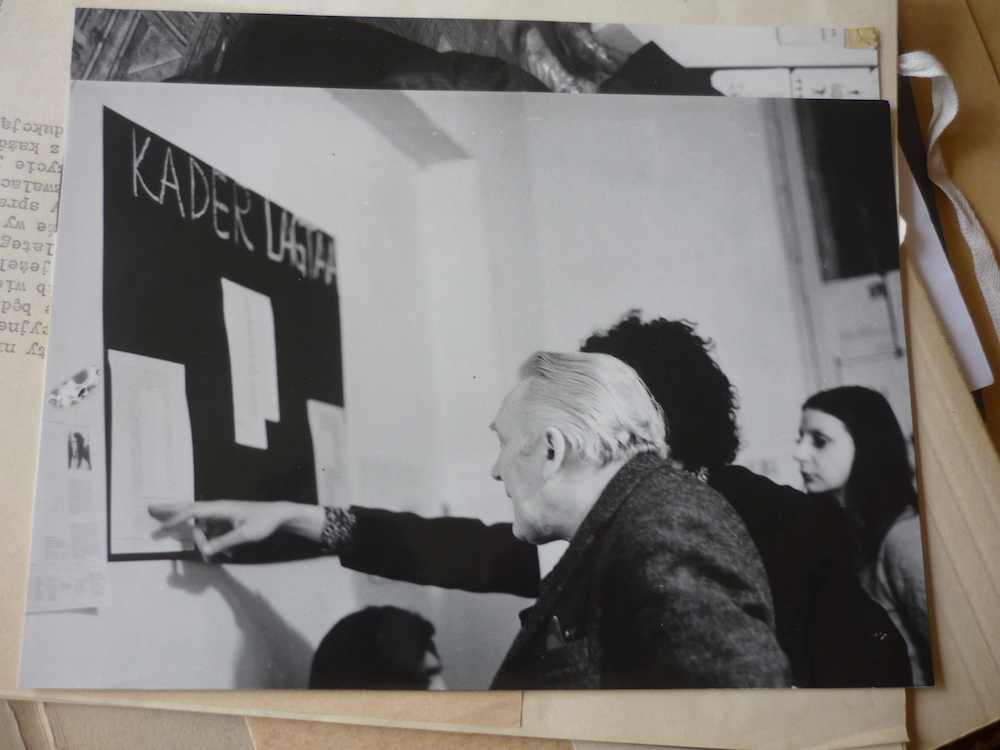


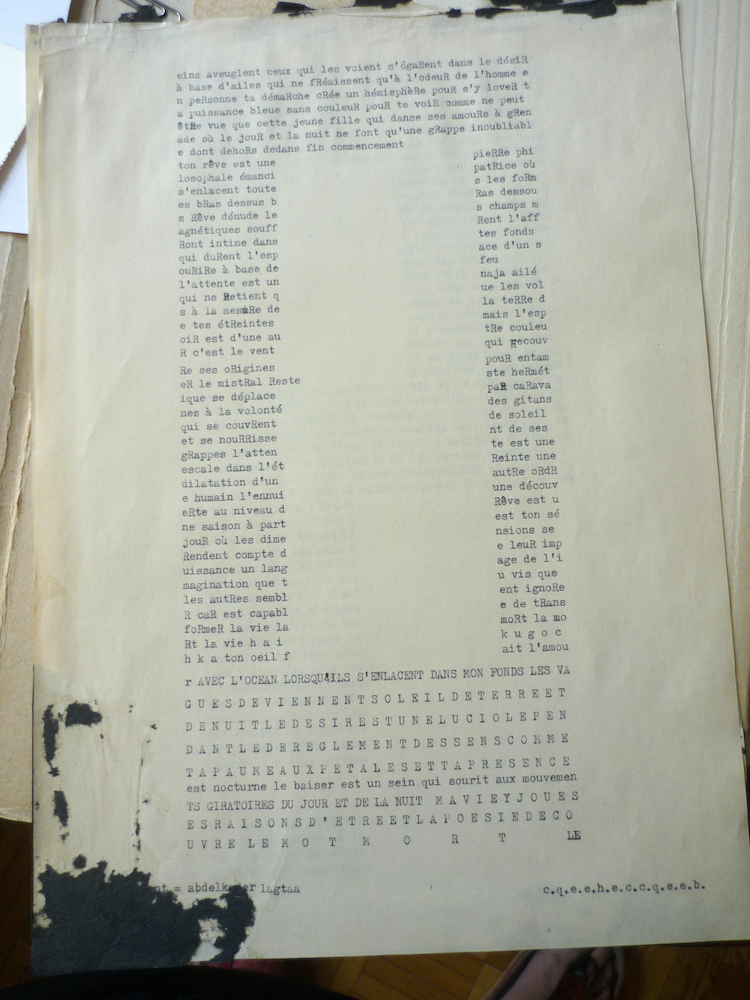
︎
Kader Lagtaa, Netainissement Linguistique [Linguistic Cleanification], 1973 (Andrzej Partum archives, courtesy of Wanda Lacrampe) Thanks to Zuzanna Zokalska
![]()
︎
Bojena and Abdelkader Lagtaa, Abdelkrim Derkaoui, on the set of Les Cendres du Clos [The Cinders of the Vineyard], 1978, Abdelkrim Derkaoui archives
(1) The Casablanca School was founded in the 1960s around the Casablanca School of Fine Arts by the Moroccan artists Mohamed Melehi, Mohamed Chabâa, Mustapha Hafid (who also studied in Poland), Mohamed Hamidi, Mohamed Ataallah, and the art historian Toni Maraini and folk art specialist Bert Flint. They re-appropriated artistic traditions as well as urban and rural architecture, and organized exhibitions in public spaces, the best known of which was held in Jemaa el-Fnaa Square in Marrakech in 1969. The Casablanca School supported the production of Mostafa Derkaoui’s first feature film in 1974. See C.A.S.A.– Casablanca Art School Archives, ed. Maud Houssais and Fatima-Zahra Lakrissa (Paris: Zaman Edition, forthcoming).
Kader Lagtaa, Netainissement Linguistique [Linguistic Cleanification], 1973 (Andrzej Partum archives, courtesy of Wanda Lacrampe) Thanks to Zuzanna Zokalska

︎
Bojena and Abdelkader Lagtaa, Abdelkrim Derkaoui, on the set of Les Cendres du Clos [The Cinders of the Vineyard], 1978, Abdelkrim Derkaoui archives
“Authenticity. That was the hot topic at the time. What is the Casablanca School?(1) It’s a way to access modernity, starting with local knowledge and especially popular culture. For us, cinema was also about that. We had progressive ideas, and we were convinced that what was needed was to take a critical look at reality. The cinema we were after had to be realistic, because that’s how the audience could relate to it, but with a critical eye: questioning the audience while presenting them with something credible and understandable. There had to be a common pathway for interaction to occur.”
Abdelkader Lagtaa, 2019(1) The Casablanca School was founded in the 1960s around the Casablanca School of Fine Arts by the Moroccan artists Mohamed Melehi, Mohamed Chabâa, Mustapha Hafid (who also studied in Poland), Mohamed Hamidi, Mohamed Ataallah, and the art historian Toni Maraini and folk art specialist Bert Flint. They re-appropriated artistic traditions as well as urban and rural architecture, and organized exhibitions in public spaces, the best known of which was held in Jemaa el-Fnaa Square in Marrakech in 1969. The Casablanca School supported the production of Mostafa Derkaoui’s first feature film in 1974. See C.A.S.A.– Casablanca Art School Archives, ed. Maud Houssais and Fatima-Zahra Lakrissa (Paris: Zaman Edition, forthcoming).
Copyright © 2020 / Léa Morin — CINIMA3 / Talitha


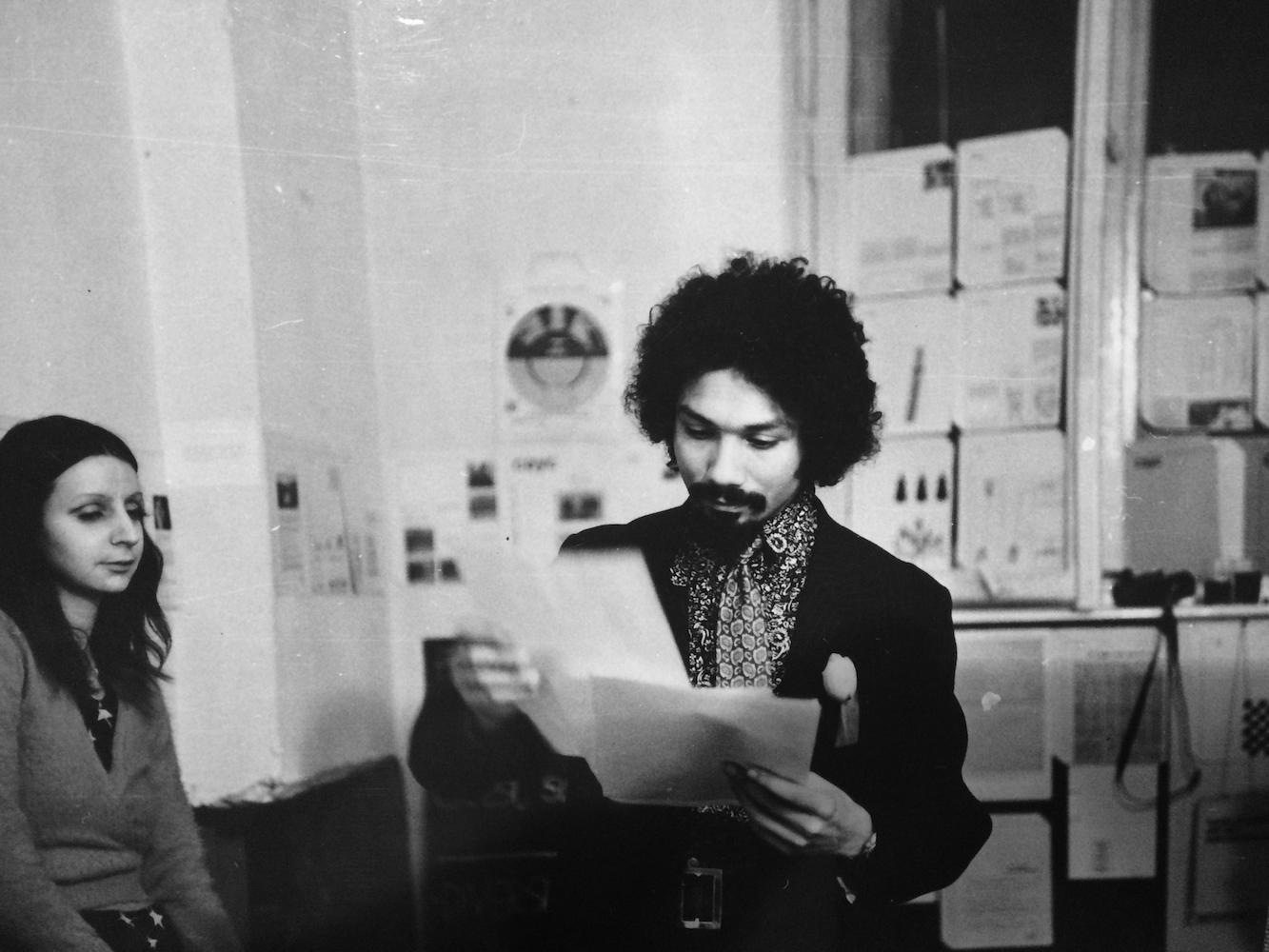
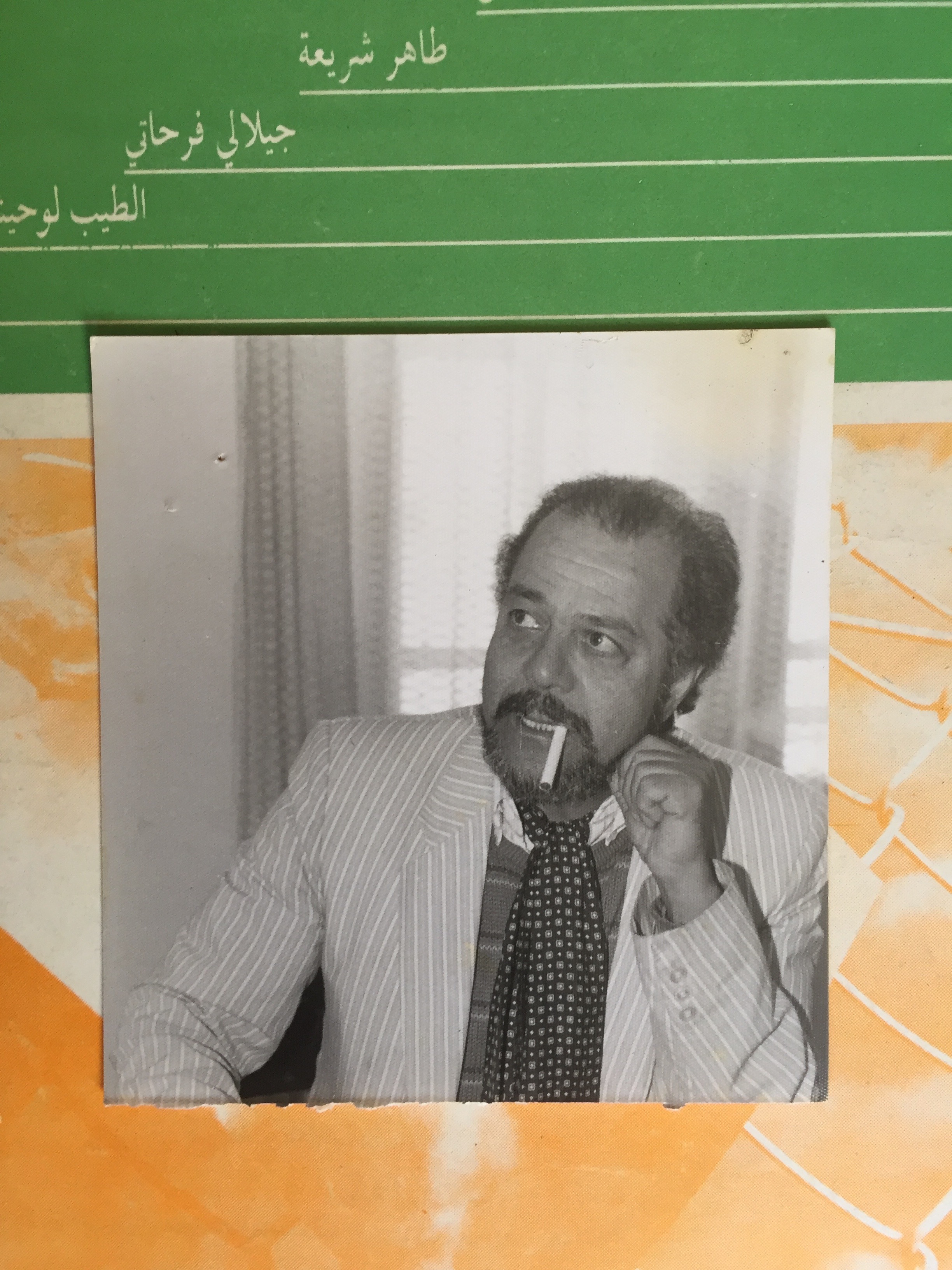 4.4
4.4 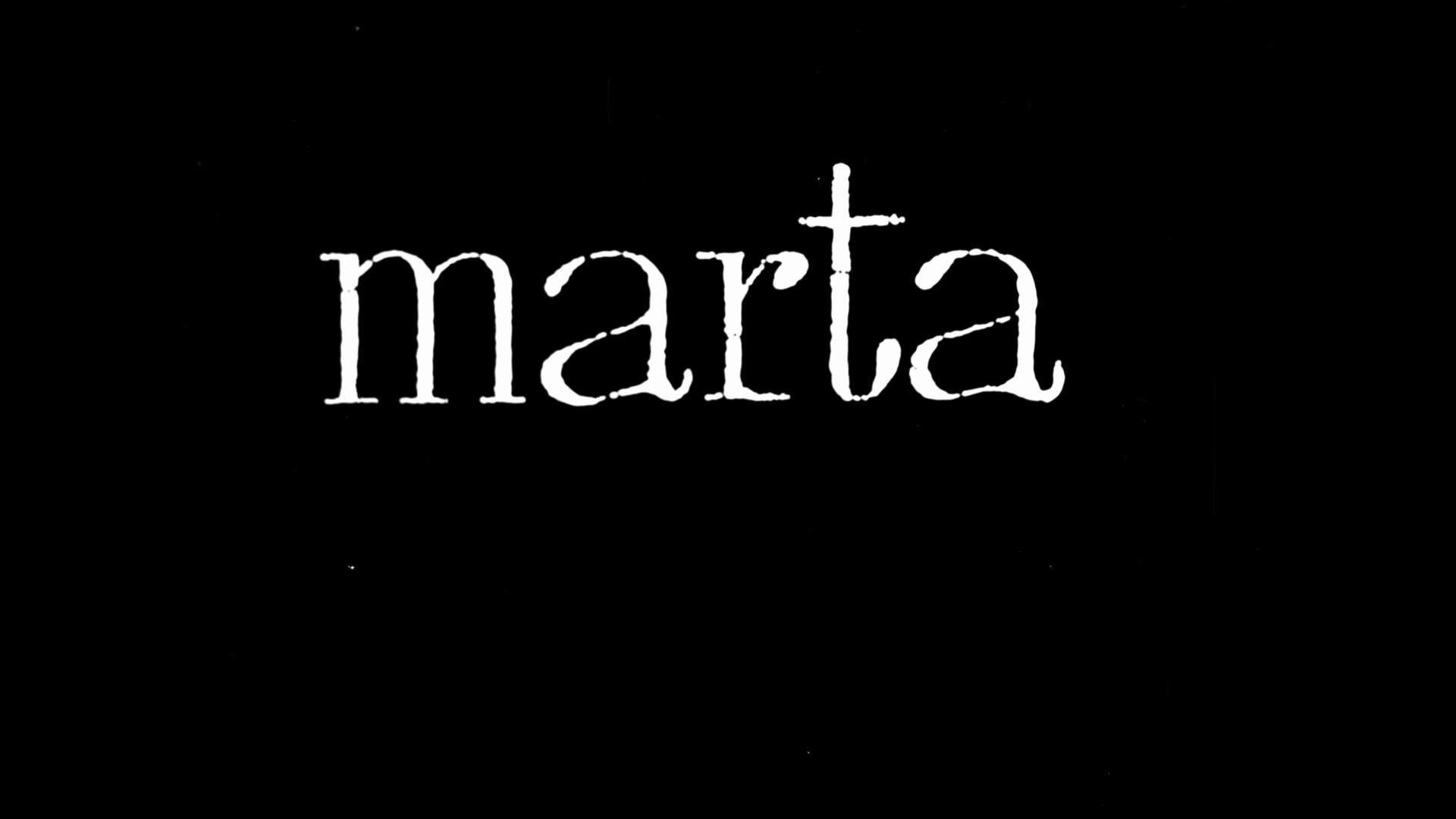 4.6
4.6 